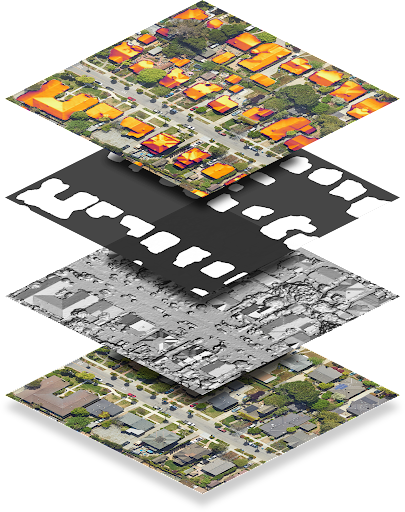
Điểm cuối dataLayers trả về dữ liệu được mã hoá dưới dạng tệp GeoTIFF. Bạn có thể dùng dữ liệu này trong mọi ứng dụng hệ thống thông tin địa lý (GIS) để thiết kế hệ thống năng lượng mặt trời.
Mỗi chuỗi trong phản hồi dataLayers chứa một URL mà bạn có thể dùng để tìm nạp GeoTIFF tương ứng. URL có hiệu lực tối đa một giờ sau khi được tạo từ yêu cầu lớp dữ liệu ban đầu. Bạn có thể lưu trữ tệp GeoTIFF trong tối đa 30 ngày.
Ngoại trừ lớp RGB, các tệp GeoTIFF không hiển thị chính xác bằng trình xem hình ảnh, vì nội dung là dữ liệu được mã hoá chứ không phải hình ảnh RGB. Bạn cũng không thể sử dụng trực tiếp các tệp GeoTIFF làm hình ảnh lớp phủ bằng Maps JavaScript API.
Bảng sau đây mô tả chi tiết từng lớp.
| Lớp | Độ sâu pixel | Độ phân giải | Mô tả |
|---|---|---|---|
| Mô hình bề mặt kỹ thuật số (DSM) | Số thực 32 bit | 0,1 m/pixel | Dữ liệu độ cao thể hiện địa hình bề mặt Trái Đất, bao gồm cả các đặc điểm tự nhiên và nhân tạo. Các giá trị được tính bằng mét so với mực nước biển. Vị trí không hợp lệ hoặc khu vực không có dữ liệu được lưu trữ dưới dạng -9999. |
| RGB | 8 bit | 0,1 m/pixel 0,25 m/pixel |
Hình ảnh từ trên không hoặc hình ảnh vệ tinh của khu vực. Tệp hình ảnh GeoTIFF chứa 3 dải tương ứng với các giá trị màu đỏ, xanh lục và xanh dương để tạo thành giá trị RGB 24 bit cho mỗi pixel. Theo mặc định, độ phân giải pixel là 0,1 m/pixel. |
| Mặt nạ toà nhà | 1 bit | 0,1 m/pixel | Một bit cho mỗi pixel cho biết liệu pixel đó có được coi là một phần của mái nhà hay không. |
| Thông lượng hằng năm | Số thực 32 bit | 0,1 m/pixel | Bản đồ thông lượng hằng năm hoặc bản đồ ánh sáng mặt trời hằng năm trên mái nhà của khu vực.
Giá trị là kWh/kW/năm. Thông lượng được tính cho mọi vị trí, không chỉ trên mái nhà. Vị trí không hợp lệ hoặc khu vực mà chúng tôi không thể tính toán thông lượng được lưu trữ dưới dạng -9999. Những vị trí nằm ngoài vùng phủ sóng của chúng tôi đều không hợp lệ. Lưu ý: Đây là thông tin về lưu lượng truy cập chưa được che giấu. |
| Thông lượng hằng tháng | Số thực 32 bit | 0,5 m/pixel | Bản đồ thông lượng hằng tháng (ánh sáng mặt trời trên mái nhà, được chia theo tháng) của khu vực. Giá trị là kWh/kW/năm. Tệp hình ảnh GeoTIFF chứa 12 dải tần tương ứng với tháng 1 đến tháng 12 theo thứ tự. |
| Bóng râm theo giờ | Số nguyên 32 bit | 1 m/pixel | 12 URL cho bản đồ bóng râm theo giờ tương ứng với tháng 1 – tháng 12, theo thứ tự. Mỗi tệp GeoTIFF chứa 24 dải tần, tương ứng với 24 giờ trong ngày. Mỗi pixel là một số nguyên 32 bit, tương ứng với (tối đa) 31 ngày của tháng đó. 1 bit có nghĩa là vị trí tương ứng có thể nhìn thấy mặt trời vào ngày đó, giờ đó, tháng đó. Vị trí không hợp lệ được lưu trữ dưới dạng -9999 và có bit 31 được đặt, vì điều đó tương ứng với ngày thứ 32 của tháng và do đó không hợp lệ. |
Giải mã các tệp raster bóng râm theo giờ
Dữ liệu bóng râm theo giờ được mã hoá trong các raster nhiều băng tần. Để tìm hiểu thêm về các kiến thức cơ bản về hình ảnh raster, hãy xem bài viết Các khái niệm về Solar API.
Khi yêu cầu dữ liệu bóng râm theo giờ, bạn có thể nhận được tối đa 12 tệp raster, mỗi tệp cho một tháng trong năm dương lịch (từ tháng 1 đến tháng 12). Mỗi hình ảnh raster bao gồm 24 lớp hoặc dải tần, tương ứng với 24 giờ trong ngày.
Mỗi dải tần được biểu thị bằng một ma trận gồm các ô hoặc pixel. Mỗi pixel có độ sâu 32 bit, tương ứng với 31 ngày (tối đa) trong tháng. Do đó, để giải mã ngày, giờ và tháng của dữ liệu bóng râm, bạn cần hiểu rõ bit, dải tần và raster mà bạn đang phân tích.
Ví dụ:để xác định xem một vị trí nhất định tại toạ độ (x, y) có nhìn thấy mặt trời lúc 4 giờ chiều ngày 22 tháng 6 hay không, hãy làm như sau:
- Đưa ra yêu cầu về lớp dữ liệu cho tất cả các lớp cho vị trí (x, y).
- Vì tháng 6 là tháng thứ sáu trong năm, hãy tìm nạp URL thứ sáu trong danh sách
hourlyShadeUrls. - Các khung giờ được cung cấp theo định dạng 24 giờ. Để lấy dữ liệu cho 4:00 PM (16:00), hãy tra cứu kênh thứ 17.
- Chỉ mục bit (ngày) từ 0. Để lấy dữ liệu cho ngày 22 tháng 6, hãy đọc bit 21.
- Các bit cung cấp dữ liệu nhị phân cho biết liệu vị trí đó có thấy mặt trời vào ngày và giờ nhất định hay không. Nếu bit là 1, thì vị trí đó có ánh nắng mặt trời. Nếu bit là 0, vị trí đó có bóng râm.
Đoạn mã sau đây tóm tắt các bước trên:
(hourly_shade[month - 1])(x, y)[hour] & (1 << (day - 1))

